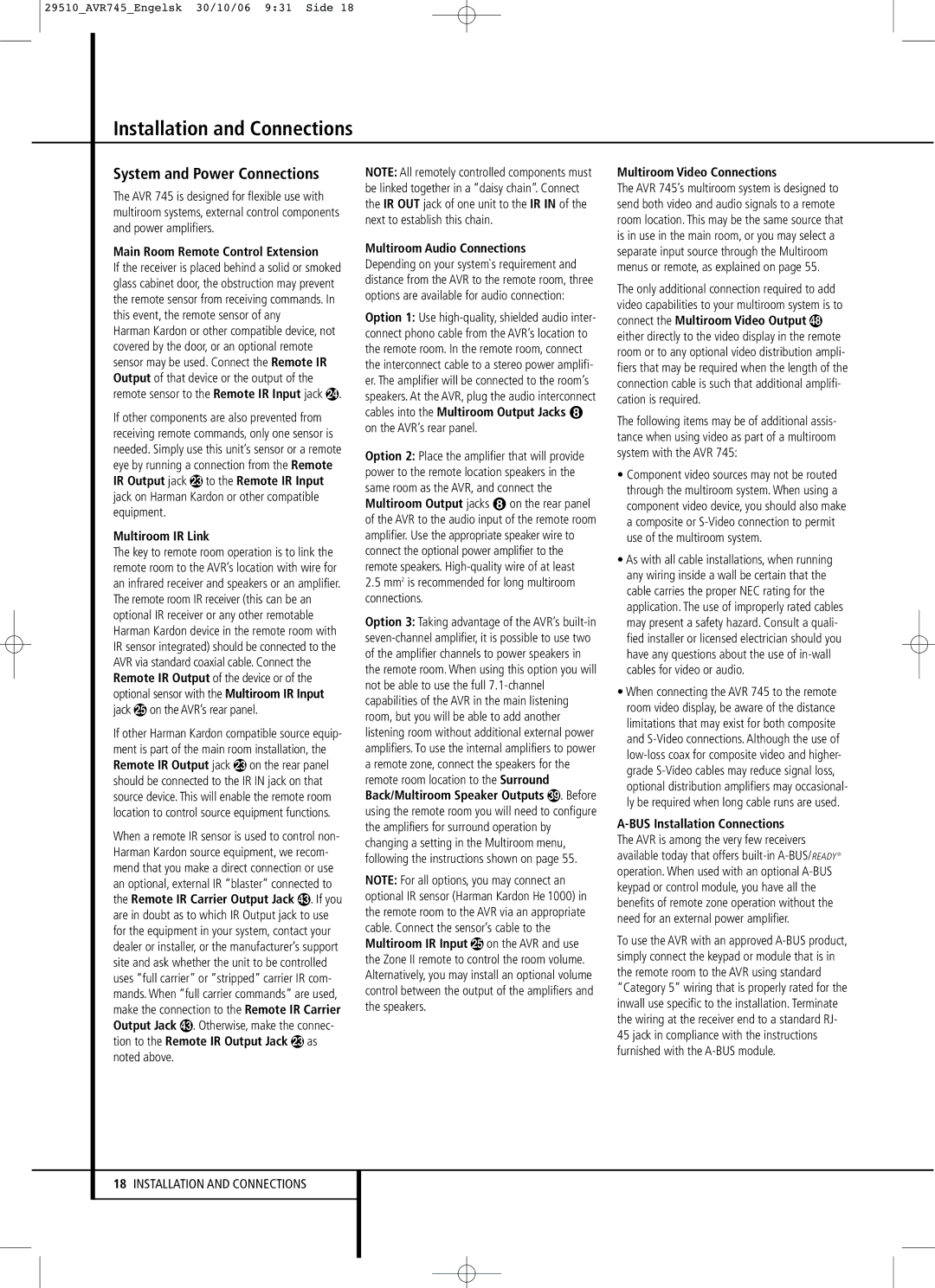
29510_AVR745_Engelsk 30/10/06 9:31 Side 18
Installation and Connections
System and Power Connections
The AVR 745 is designed for flexible use with multiroom systems, external control components and power amplifiers.
Main Room Remote Control Extension
If the receiver is placed behind a solid or smoked glass cabinet door, the obstruction may prevent the remote sensor from receiving commands. In this event, the remote sensor of any
Harman Kardon or other compatible device, not covered by the door, or an optional remote sensor may be used. Connect the Remote IR Output of that device or the output of the remote sensor to the Remote IR Input jack .
If other components are also prevented from receiving remote commands, only one sensor is needed. Simply use this unit’s sensor or a remote eye by running a connection from the Remote IR Output jack to the Remote IR Input jack on Harman Kardon or other compatible equipment.
Multiroom IR Link
The key to remote room operation is to link the remote room to the AVR’s location with wire for an infrared receiver and speakers or an amplifier. The remote room IR receiver (this can be an optional IR receiver or any other remotable Harman Kardon device in the remote room with IR sensor integrated) should be connected to the AVR via standard coaxial cable. Connect the Remote IR Output of the device or of the optional sensor with the Multiroom IR Input
jack | on the AVR’s rear panel. |
If other Harman Kardon compatible source equip- ment is part of the main room installation, the Remote IR Output jack on the rear panel should be connected to the IR IN jack on that source device. This will enable the remote room location to control source equipment functions.
When a remote IR sensor is used to control non- Harman Kardon source equipment, we recom- mend that you make a direct connection or use an optional, external IR “blaster” connected to
the Remote IR Carrier Output Jack . If you
are in doubt as to which IR Output jack to use for the equipment in your system, contact your dealer or installer, or the manufacturer’s support site and ask whether the unit to be controlled uses “full carrier” or “stripped” carrier IR com- mands. When “full carrier commands” are used, make the connection to the Remote IR Carrier Output Jack . Otherwise, make the connec- tion to the Remote IR Output Jack as noted above.
NOTE: All remotely controlled components must be linked together in a “daisy chain”. Connect the IR OUT jack of one unit to the IR IN of the next to establish this chain.
Multiroom Audio Connections Depending on your system`s requirement and distance from the AVR to the remote room, three options are available for audio connection:
Option 1: Use
on the AVR’s rear panel.
Option 2: Place the amplifier that will provide power to the remote location speakers in the same room as the AVR, and connect the Multiroom Output jacks on the rear panel of the AVR to the audio input of the remote room amplifier. Use the appropriate speaker wire to connect the optional power amplifier to the remote speakers.
2.5mm2 is recommended for long multiroom connections.
Option 3: Taking advantage of the AVR’s
NOTE: For all options, you may connect an optional IR sensor (Harman Kardon He 1000) in the remote room to the AVR via an appropriate cable. Connect the sensor’s cable to the Multiroom IR Input on the AVR and use the Zone II remote to control the room volume. Alternatively, you may install an optional volume control between the output of the amplifiers and the speakers.
Multiroom Video Connections
The AVR 745’s multiroom system is designed to send both video and audio signals to a remote room location. This may be the same source that is in use in the main room, or you may select a separate input source through the Multiroom menus or remote, as explained on page 55.
The only additional connection required to add video capabilities to your multiroom system is to connect the Multiroom Video Output either directly to the video display in the remote room or to any optional video distribution ampli- fiers that may be required when the length of the connection cable is such that additional amplifi- cation is required.
The following items may be of additional assis- tance when using video as part of a multiroom system with the AVR 745:
•Component video sources may not be routed through the multiroom system. When using a component video device, you should also make a composite or
•As with all cable installations, when running any wiring inside a wall be certain that the cable carries the proper NEC rating for the application. The use of improperly rated cables may present a safety hazard. Consult a quali- fied installer or licensed electrician should you have any questions about the use of
•When connecting the AVR 745 to the remote room video display, be aware of the distance limitations that may exist for both composite and
To use the AVR with an approved
18INSTALLATION AND CONNECTIONS
